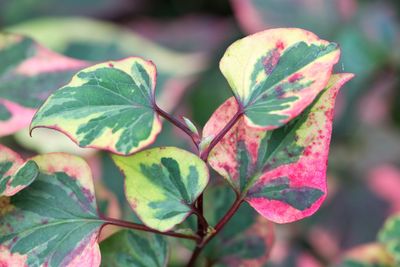About Chameleon Plants
The chameleon plant is very pretty with its lavender-tinged, heart-shaped leaves and easy-going nature. But it is this nature that becomes the problem. Chameleon plants grow in USDA zones 5 to 11, in moist to dry soils, full sun to partial shade. Once they get going, there is very little that can stop the plants. Controlling chameleon plants is one of those challenges that will test your determination. Fortunately, the keys on how to get rid of Houttuynia are below. The chameleon plant is a very useful groundcover or trailing plant. Because it doesn’t mind tough areas and needs little care, it is a perfect plant in those respects. It’s only when you want to remove or control it that the plant’s true nature comes out. Houttuynia spreads through rhizomes, which are very fragile and break apart easily. Any small part of the rhizome or stem left behind in the soil will resprout. This makes chameleon plant eradication extremely challenging. The fleshy rhizomes also range quite deep and wide, making it even harder to dig out every section. And because foliar sprays result in the death of leaves and stems but don’t always kill roots, this scrappy plant will just come back again, season after season.
Controlling Chameleon Plants Naturally
If you are a glutton for punishment, you can remove some of the plants without chemicals. The process will take several seasons but does not require chemicals. Start at the outer edges of the patch, digging about 2 feet (0.5 m.) outside of the visible foliage and stems. Remove rhizomes as you find them and bag them. Dig down at least 12 inches (30.5 cm.). It is useful to have a large tarp handy to place shovels full of soil and sift through for pieces of rhizome, leaves, or stems. Take sifted soil and store it in another part of the garden. Once you have gone through the entire bed, you can return the “cleaned” soil. Keep an eye on the area and remove any plants that sprout. You may have to do the entire process again for the next season or two.
How to Get Rid of Houttuynia for Good
Total chameleon plant eradication is possible but it takes several years. Unfortunately, back-breaking labor and chemicals are the components necessary for killing chameleon plants. Although the plants are fairly resistant to chemical herbicides, glyphosate seems to be an effective type. Use with caution and look for a formula that is labeled for brush or stumps. In order to minimize the amount used and prevent drift, cut back the plants and paint or drip a small amount of the chemical on the open stem. This reduces the amount you must use and gets the formula right on the plant. You may still have to reapply the next season, but this has an excellent chance of killing the plant in time. Note: Chemical control should only be used as a last resort, as organic approaches are safer and much more environmentally friendly.
